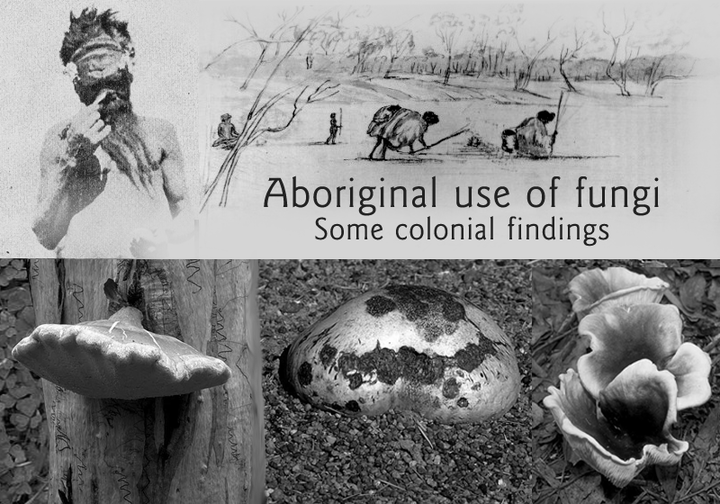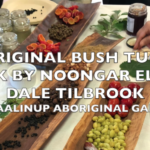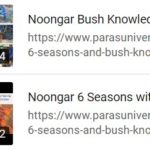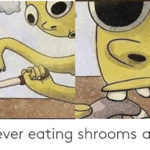In 1841 the explorer George Grey published an account of his travels in Western Australia and reported that he’d seen seven species of fungi eaten by the Aborigines. He commented that “The different kinds of fungus are very good. In certain seasons of the year they are abundant, and the natives eat them greedily”. The Tasmanian George Robinson wrote: “Various are the fungus which the natives eat, and all are known to them by different qualities which they possess, and all are known by different names”.
Arpad Kalotas in Fungi of Australia notes a Central Australian belief, as recorded by the anthropologists B Spencer and FJ Gillen at the beginning of the 20th century: “Falling stars appear to be associated with the idea of evil magic in many tribes. The Arunta believe that mushrooms and toadstools are fallen stars, and look upon them as being endowed with arungquiltha (evil magic) and therefore will not eat them.” However, Kalotas comments that this cannot apply to all fungi, for a number are eaten by the central Australian people.
James Drummond, an early settler and plant collector in Western Australia talked of a large luminous mushroom (most likely Omphalotus nidiformis) and reported that several Aboriginal people, when they saw it “…cried out ‘Chinga!’ their name for a spirit, and seemed much afraid of it”.
While a number of people in the 20th century have documented Aboriginal fungal use, it is worth making special mention of John Cleland. He had broad scientific interests, including anthropology, was a very knowledgeable mycologist and so contributed significantly to knowledge of fungal use.
Fungi are the second largest group of organisms in the world, after the insects.
Although primarily microscopic and thus usually unseen, fungi are ubiquitous organisms that mediate critical biological and ecological processes. They have significant roles as saprotrophs in the breakdown and nutrient cycling of plant and animal remains, as parasites and disease agents, as food, and in mutualistic relationships.
Amazon #ads

There is still much scope for ethnomycological fieldwork in Australia. Very few useful fungi have been recorded and it is possible that there is more knowledge still in peoples’ heads. Geographically, there are large blank areas with no recorded uses, but away from the desert areas much native knowledge has probably been lost due to more concentrated European settlement and agriculture. But, who knows what can be found from papers and diaries still sitting in libraries or archives. It would also pay to check the published statements in some of the early European writings and to confirm species identifications. For the moment, here are the uses of the fungi reported in the chapter by Kalotas.

FUNGI IMAGES ON MEME:
LEFT: Laetiporus portentosus (formerly called Piptoporus portentosus)
What is probably this species of polypore, was eaten by Aborigines in Tasmania, possibly as an emergency food. In Tasmania, South Australia and Western Australia a fungus, sounding like this one, was used as tinder and to carry fire as it would smoulder all day.
CENTRE: Pisolithus species, early stage (PUFFBALLS)
When fully mature, the fruiting bodies of Pisolithus species produce copious amounts of powdery spores. Before that, much of the fruiting body will have a tarry consistency and at that stage it was used on wounds. It was also eaten when still very young, but most likely as an emergency food. In various published accounts you will see the name Pisolthus tinctorius used. This overseas name has been used almost automatically (and probably incorrectly) for Australian Pisolithus specimens.
RIGHT: Omphalotus nidiformis
James Drummond, an early settler and plant collector in Western Australia talked of a large luminous mushroom (most likely Omphalotus nidiformis) and reported that several Aboriginal people, when they saw it “…cried out ‘Chinga!’ their name for a spirit, and seemed much afraid of it”.
MORE HERE (Provides Images and info on a varieties)
Aboriginal use of fungi (Government Herbarium) http://tiny.cc/AboriginalFungus
MOST INFO OBTAINED FROM THIS BOOK (Out of Print)
Volume 1B – Introduction: Fungi in the Environment http://tiny.cc/Fungi-Vol1B
BUT can be borrowed or ordered in to borrow from mosts public libraries.
Amazon #ads







